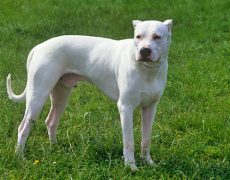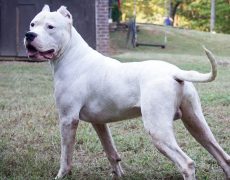Dogo Argentino
Powerful, and athletic, Dogo Argentino is a big dog breed with a full white body. Bred to hunt big games like wild boar and puma, these muscular dogs have a broad head, longish and robust muzzle, almond-shaped eyes, high set ears, and a low set, long and thick tail. Some of them are marked with a black spot on their head, which is though not accepted by many breeder clubs. In the recent times, this gentle, cheerful and friendly breed has been employed as service and police dogs.
Dogo Argentino Pictures
- Argentinian Mastiff
- Black Dogo Argentino
- Dogo Argentino Dog
- Dogo Argentino Dogs
- Dogo Argentino Female
- Dogo Argentino Full Grown
- Dogo Argentino Mix
- Dogo Argentino Pics
- Dogo Argentino Pictures
- Dogo Argentino Puppies
- Dogo Argentino Puppy
- Dogo Argentino Running
- Dogo Argentino Teeth
- Dogo Argentino
- Dogos Argentinos
- Pictures Dogo Argentino
- Pictures of Dogo Argentino
- The Dogo Argentino
Quick Information
| Other names | Argentine Dogo, Argentinian Mastiff |
| Common nicknames | Dogo |
| Coat | Short and sleek |
| Color | White |
| Breed type | Purebred |
| Group | Hunting dogs, Molossers, Catch dog breeds |
| Average lifespan | 9 to 15 years |
| Size (How big do they get) | Big |
| Height | Male: 24 to 27 inches; Female: 23 to 26 inches |
| Weight | 80 to 100 lbs |
| Litter size | 4 to 8 puppies |
| Behavioral characteristics | Intelligent, alert, brave, protective, affectionate |
| Good with children | Yes ( of the family) |
| Climate Compatibility | Its coat helps it to adapt to warm and cold climate, but extreme heat should be avoided |
| Braking tendency | Moderate |
| Shedding (Does it shed) | On an average basis |
| Hypoallergenic | No |
| Competitive Registration Qualification/ Information | AKC/FSS, FCI, UKC, ACA, ACR, BBC, DRA, FCI, FCA, NAPR, NKC |
| Country | Argentina |
Dogo Argentino Puppies Video
History
Originating in the Cordoban province, the credit for creating it goes to Dr. Antonio Nores Martinez. Being passionate about dogs, his motive was to develop a breed that would hunt big games as well as be loyal and guard his household. For this purpose, he went on to crossbreed a host of purebreds, like the Bull Terrier, Great Dane, Spanish Mastiff, Boxer, Pyrenean Mastiff and Dogue de Bordeaux with the strongly built Cordoba Fighting dog (presently extinct), marked for its huge size and ferocity. The resultant breed was not just adept at hunting preys but also proved to be a loyal companion as well as a fierce protector. It gained acceptance from the FCI in 1973, being the only Argentinian breed to have done so till date. In 1985, the Dogo Argentino Club was developed to work towards the betterment of this breed. The American Kennel Club has registered it in its Miscellaneous Class at present.
Is it a fighting dog
Though a descendant of the Cordoba fighting dog, the aggressive traits of the latter was bred out for the purpose of producing a hunting dog that would be cooperative and even-tempered, suitable for working cooperatively in packs. However, its fearlessness and high stamina made it be used as fighting dogs, thus putting a ban on it or restricting its ownership in countries like Australia, Fiji, Iceland, Denmark, Ukraine, New Zealand, Fiji, Cayman Islands and Singapore. The Dangerous Dog Act 1991 of the United Kingdom mentions the ownership of Dogo Argentino as illegal in the country without lawful permission.
Attack
Though the purpose of breeding a Dogo Argentino was to get a non-aggressive yet brave and agile hunting dog, there have been a lot of reports of late about their attacks on humans. In June this year, 28-year-old Jenna Sutphin of Huntingtown, Maryland, succumbed to injuries when she was bitten by a Dogo, sustaining injuries behind her head and neck. In another incident, a single mother of Montana village was severely injured by a Dogo.
Temperament and Personality
Its fierce, brave and alert nature, combined with its affectionate bonding towards its family, indeed gives the Dogo Argentino a versatile disposition.
Being a fierce and alert protector, they do not mingle well with strangers and bark to intimate their family the moment they spot an intruder or sense anything unusual within the bounds of their home.
Besides, their protective instincts, they are tenacious with a strong sense of smell, thus excelling as great watchdogs.
They share a great rapport with children particularly the ones belonging to their family, however, if you have your neighbor’s or friend’s kids visiting you, it is essential to leash your pet or supervise their interaction to avoid any unpleasant happenings.
Since they have an intense prey drive, all because of their hunting background, keeping them with smaller dogs or pets and cats would not be a safe option.
Care
Exercise
Being highly energetic and active, they have increased exercise needs, with a long walk alongside ample playtime being sufficient to keep them physically and mentally fit. You can even take them along when you go hiking or swimming. Training them for participating in dog sports like rally, obedience and agility would be another way of exercising your Dogo. They would do well in homes in the countryside or houses with large yards rather than small apartments owing to their active nature. Avoid exposing it to sunlight for a long time since its light color may cause it to be sunburned easily.
Grooming
Its short coat is not too hard to manage but since it is big, brushing the entire coat well could at times be troublesome. Comb it once or two times in a week using a brush with firm bristles or even a mitt to maintain the quality of its coat. Bathe it once in three months or earlier in case it gets dirty. Trimming its nails, cleaning its ears and eyes and brushing its teeth are some of the other hygiene measures needed to be followed on a regular basis.
Health Problems
One of the genetic problems the Dogo might be prone to is pigment-related deafness— an issue seen in almost all white dogs like the Dalmatian white Bull Terrier or white Boxer. This could affect some of the Dogos though not all, making them either uniaurally (single ear) or binaurally (both ears) deaf. Reputable breeders are often seen to have the Dogo puppies undergo a B.A.E.R test (Brainstem Auditory Evoked Response) to determine whether they are deaf or not.
Other health issues include hip dysplasia, hypothyroidism, laryngeal paralysis, and glaucoma.
Training
Though it has a high level of intelligence, its stubborn, domineering and strong-willed nature does not make it a suitable choice for first-time owners, thus requiring a firm and experienced taskmaster to tackle it in a tactful way.
- Because of its wariness and suspicious nature towards strangers, socialization should begin right from your Dogo’s puppy days. By exposing your dog to different kinds of people and pets, it will eventually learn to eliminate the good from the bad and bark or be alert only if it senses anything wrong or unusual.
- Obedience training is essential for the Dogo puppies to instill in them discipline and help them get over their stubborn and strong-willed attitude. If your Dogo is stubborn, it is essential for you to go slow in the training process, create a positive association and be consistent throughout the training process.
- Because of its strong prey drive training it to use a leash from an early age is a mandate.
Feeding
While planning the diet for your Dogo, make sure you give it high-quality dry dog food. A homemade diet can also be provided simultaneously, though it is essential to have a word with your vet about the same who would be able to devise a food chart based on your dog’s requirements. Keep a check on the treats as overfeeding could aggravate hip dysplasia that these dogs are prone to suffer from.























